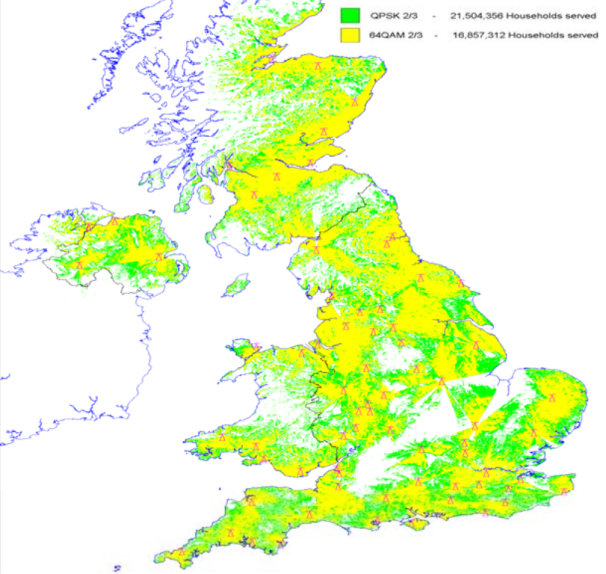Local digital TV or a 7th multiplex coming soon?
 Brian Butterworth published on UK Free TV
Brian Butterworth published on UK Free TV Digital switchover will mean the wholesale reorganization of the UK terrestrial broadcast frequencies. The 'cleared spectrum' and 'programme making and special events' are dealt with elsewhere in this section. The third aspect is what Ofcom call 'interleaved spectrum' which has only one real potential use: local digital television.
Ofcom have identified 81 transmitters that have, they calculate, at least one frequency that cannot be used for one of the existing six Freeview transmission multiplexes, but can be used for a low-power service.
These sites comprise most of the current Freeview transmitters except Aberdare, Blaenplwyf, Chatton, Chesterfield, Hastings, Idle, Pontypool and Torosay; plus these transmitters:
- Balgownie on C51
- Fremont Point on C48
- Kidderminster on C56
- Londonderry on C52
- Londonderry on C22
- Luton on C45
- Perth on C30
- Poole on C50
- Port St Mary (IoM) on C51
- Tay Bridge on C51
Some transmitters will have two frequencies:
Angus, Beacon Hill, Belmont, Bilsdale, Black Hill, Bluebell Hill, Bressay, Brierley Hill, Bristol Kings Weston, Bromsgrove, Brougher Mountain, Caldbeck, Caradon Hill, Carmel, Craigkelly, Crystal Palace, Darvel, Divis, Dover, Durris, Eitshal, Emley Moor, Fenham, Fenton, Guildford, Hannington, Heathfield, Hemel Hempstead, Huntshaw Cross, Ilchester Crescent, Keelylang Hill, Keighley, Kilvey Hill, Knock More, Lancaster, Lark Stoke, Limavady, Llanddona, Malvern, Mendip, Midhurst, Moel-Y-Parc, Nottingham, Olivers Mount, Oxford, Pendle Forest, Plympton, Pontop Pike, Presely, Redruth, Reigate, Ridge Hill, Rosemarkie, Rosneath, Rowridge, Rumster Forest, Saddleworth, Salisbury, Sandy Heath, Selkirk, Sheffield, Stockland Hill, Storeton, Sudbury, Sutton Coldfield, Tacolneston, The Wrekin, Tunbridge Wells, Waltham, Wenvoe, Whitehawk Hill, Winter Hill.
In addition the Winter Hill transmitter has a third frequency.
Because these frequencies form part of the national Freeview plan, the use at these transmitter will have to be at low power and also restricted in their coverage. In effect, they will cover an area that will be much less than the full-power Freeview transmissions, even less than the pre-switchover multiplex 2 and A coverage.
Ofcom may offer these 'lots' of frequencies as single packages, or may package the sale of them into regional or national groups. However, Ofcom is considering packaging one of the frequencies from the above list of 25 transmitters into a single UK-wide nation 'large lot'. This could mean in effect a seventh national Freeview multiplex, albeit with restricted coverage.
As the frequencies will only be available for use once switchover has happened on the transmitter, the services will start at or after each region's switchover. In addition, not all these frequencies are 'in group', so only households that have upgraded to a wideband aerial will receive them. Bidders will win a licence to transmit from the regional switchover date until 2026. The reserve price for the licence will be 25,000 per lot.
Whilst it is technically possible that these frequencies could be used for DVB-H, WiMax or 3G, it seems most likely that the will be used for local television or standard DTT (either SD or HD).

This Ofcom map shows the areas that are covered. The green areas are those that can be used for local TV (using QSPK transmission mode), the yellow areas those possible for national coverage (using 64QAM mode). Ofcom calculates the latter is 51% of England, 79% of Scotland, 52% of Wales and 32% of Northern Ireland.
Ofcom says that "Local TV may be operated on a wholly commercial basis, as a not-for-profit community model, or as a combination of both. Examples of existing terrestrial local TV services include Channel M in Manchester (backed by Guardian Media Group), MATV in Leicester (a commercial operation targeting the citys South Asian community) and NvTv in Belfast (a not for profit community model funded by Northern Irish arts, education and training bodies)."
Help with TV/radio stations?
In this section